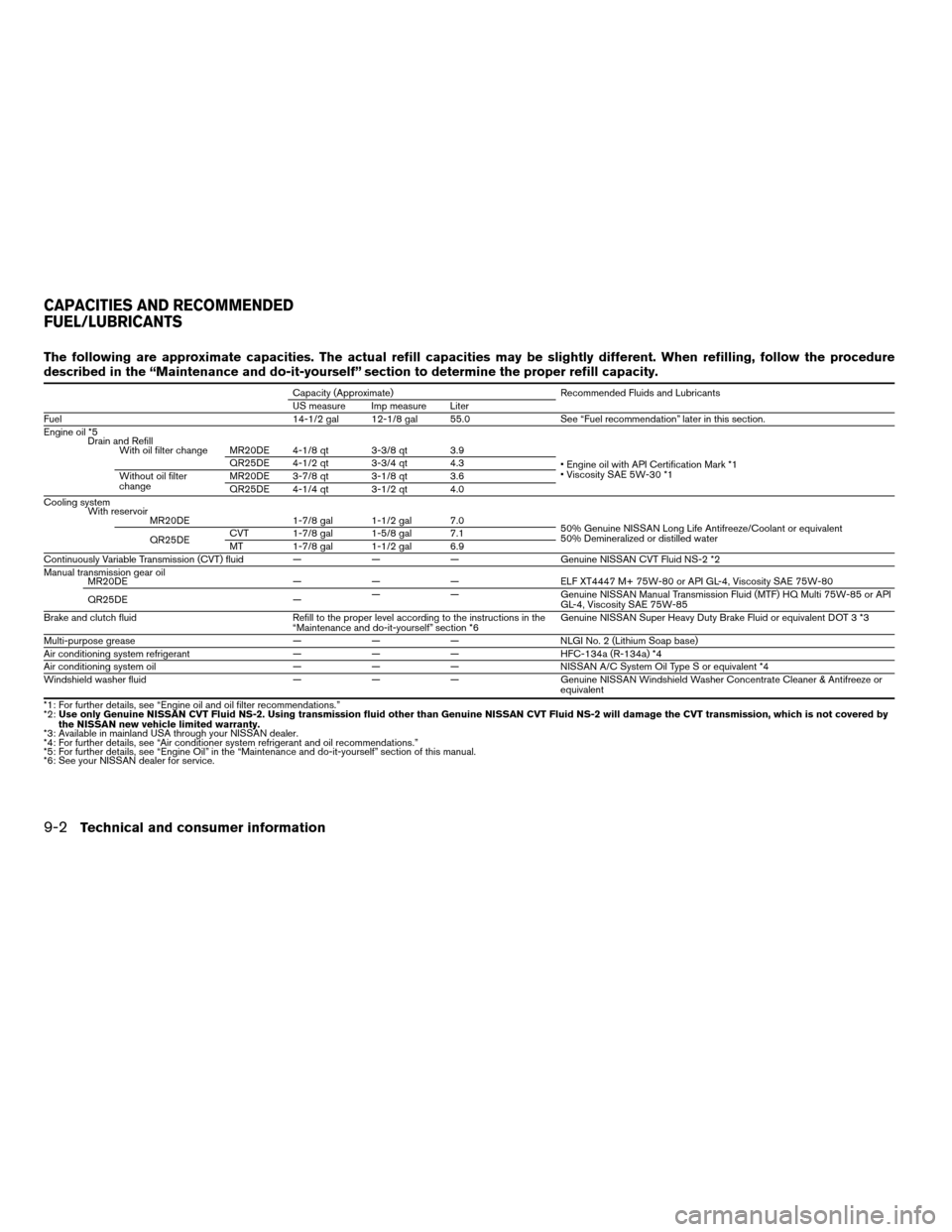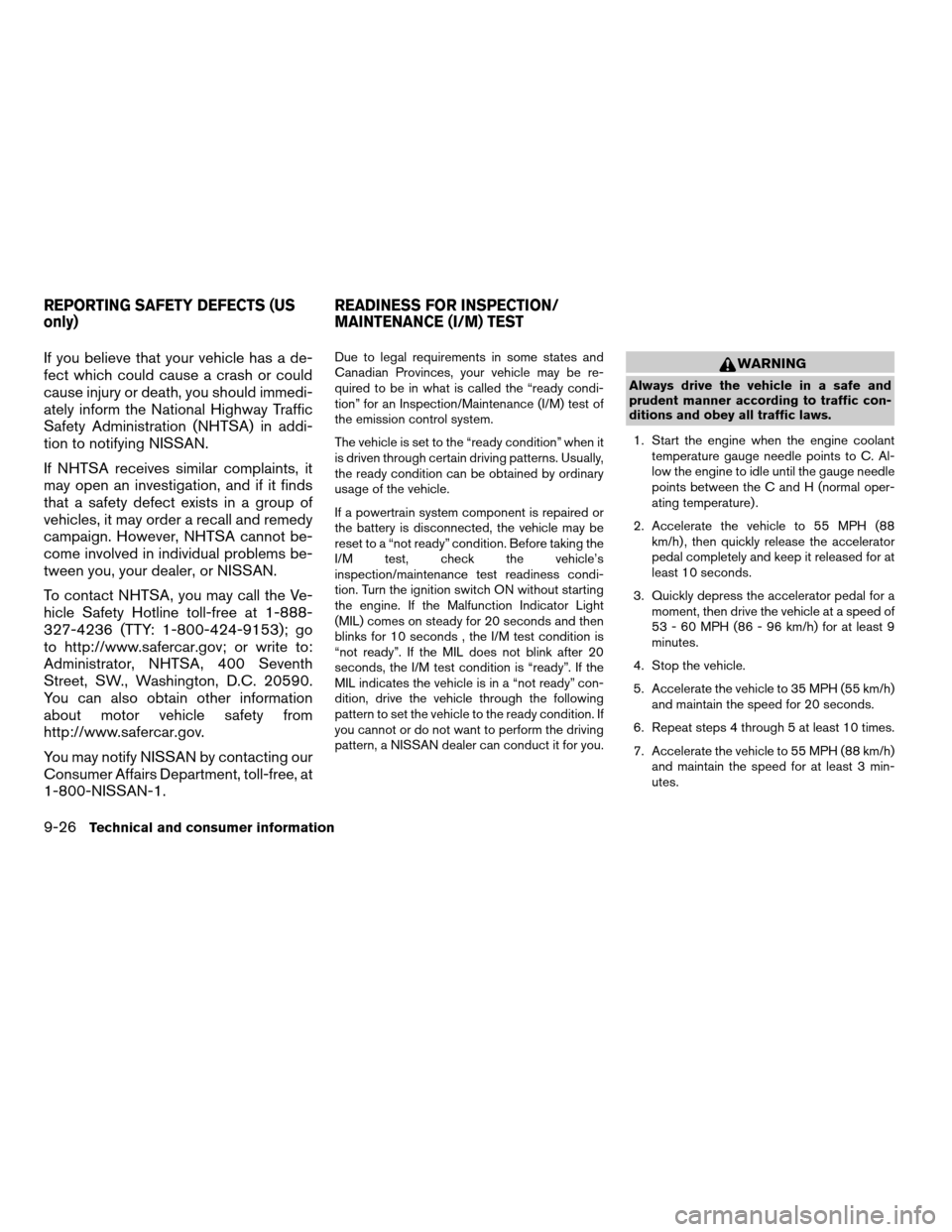2008 NISSAN SENTRA coolant
[x] Cancel search: coolantPage 251 of 328

CHANGING ENGINE COOLANT
A NISSAN dealer can change the engine coolant.
The service procedure can be found in the
NISSAN Service Manual.
Improper servicing can result in reduced
heater performance and engine overheat-
ing.
WARNING
cTo avoid the danger of being scalded,
never change the coolant when the en-
gine is hot.
cNever remove the radiator cap when the
engine is hot. Serious burns could be
caused by high pressure fluid escaping
from the radiator.
cAvoid direct skin contact with used
coolant. If skin contact is made, wash
thoroughly with soap or hand cleaner
as soon as possible.
cKeep coolant out of the reach of chil-
dren and pets.
Engine coolant must be disposed of properly.
Check your local regulations.
CHECKING ENGINE OIL LEVEL
1. Park the vehicle on a level surface and apply
the parking brake.
2. Start the engine and let it idle until it reaches
operating temperature.
3. Turn off the engine.Wait more than 10
minutes for the oil to drain back into
the oil pan.
4. Remove the dipstick and wipe it clean. Re-
insert it all the way.
Type B
LDI0589
Type A
WDI0591
ENGINE OIL
Maintenance and do-it-yourself8-9
ZREVIEW COPYÐ2008 Sentra(sen)
Owners ManualÐUSA_English(nna)
01/22/08Ðdebbie
X
Page 257 of 328

Refill the reservoir more frequently when driving
conditions require an increased amount of win-
dow washer fluid.
Recommended fluid is Genuine NISSAN Wind-
shield Washer Concentrate Cleaner & Anti-
freeze or equivalent.
CAUTION
cDo not substitute engine anti-freeze
coolant for window washer solution.
This may result in damage to the paint.
cDo not fill the window washer reservoir
tank with washer fluid concentrates at
full strength. Some methyl alcohol
based washer fluid concentrates may
permanently stain the grille if spilled
while filling the window washer reser-
voir tank.
cPre-mix washer fluid concentrates with
water to the manufacturer’s recom-
mended levels before pouring the fluid
into the window washer reservoir tank.
Do not use the window washer reservoir
tank to mix the washer fluid concen-
trate and water.cKeep the battery surface clean and dry.
Clean the battery with a solution of baking
soda and water.
cMake certain the terminal connections are
clean and securely tightened.
cIf the vehicle is not to be used for 30 days or
longer, disconnect the negative (-) battery
terminal cable to prevent discharge.
WARNING
cDo not expose the battery to flames or
electrical sparks. Hydrogen gas gener-
ated by the battery is explosive. Do not
allow battery fluid to contact your skin,
eyes, fabrics or painted surfaces. After
touching a battery or battery cap, do not
touch or rub your eyes. Thoroughly
wash your hands. If the acid contacts
your eyes, skin or clothing, immediately
flush with water for at least 15 minutes
and seek medical attention.
cDo not operate the vehicle if the fluid in
the battery is low. Low battery fluid can
cause a higher load on the battery
which can generate heat, reduce bat-
tery life, and in some cases lead to an
explosion.cWhen working on or near a battery, al-
ways wear suitable eye protection and
remove all jewelry.
cBattery posts, terminals and related ac-
cessories contain lead and lead com-
pounds. Wash hands after handling.
cKeep battery out of the reach of
children.
BATTERY
Maintenance and do-it-yourself8-15
ZREVIEW COPYÐ2008 Sentra(sen)
Owners ManualÐUSA_English(nna)
01/22/08Ðdebbie
X
Page 286 of 328

The following are approximate capacities. The actual refill capacities may be slightly different. When refilling, follow the procedure
described in the “Maintenance and do-it-yourself” section to determine the proper refill capacity.
Capacity (Approximate) Recommended Fluids and Lubricants
US measure Imp measure Liter
Fuel 14-1/2 gal 12-1/8 gal 55.0 See “Fuel recommendation” later in this section.
Engine oil *5
Drain and Refill
With oil filter change MR20DE 4-1/8 qt 3-3/8 qt 3.9
• Engine oil with API Certification Mark *1
• Viscosity SAE 5W-30 *1 QR25DE 4-1/2 qt 3-3/4 qt 4.3
Without oil filter
changeMR20DE 3-7/8 qt 3-1/8 qt 3.6
QR25DE 4-1/4 qt 3-1/2 qt 4.0
Cooling system
With reservoir
MR20DE 1-7/8 gal 1-1/2 gal 7.0
50% Genuine NISSAN Long Life Antifreeze/Coolant or equivalent
50% Demineralized or distilled water
QR25DECVT 1-7/8 gal 1-5/8 gal 7.1
MT 1-7/8 gal 1-1/2 gal 6.9
Continuously Variable Transmission (CVT) fluid — — — Genuine NISSAN CVT Fluid NS-2 *2
Manual transmission gear oil
MR20DE — — — ELF XT4447 M+ 75W-80 or API GL-4, Viscosity SAE 75W-80
QR25DE —— — Genuine NISSAN Manual Transmission Fluid (MTF) HQ Multi 75W-85 or API
GL-4, Viscosity SAE 75W-85
Brake and clutch fluid Refill to the proper level according to the instructions in the
“Maintenance and do-it-yourself” section *6Genuine NISSAN Super Heavy Duty Brake Fluid or equivalent DOT 3 *3
Multi-purpose grease — — — NLGI No. 2 (Lithium Soap base)
Air conditioning system refrigerant — — — HFC-134a (R-134a) *4
Air conditioning system oil — — — NISSAN A/C System Oil Type S or equivalent *4
Windshield washer fluid — — — Genuine NISSAN Windshield Washer Concentrate Cleaner & Antifreeze or
equivalent
*1: For further details, see “Engine oil and oil filter recommendations.”
*2:Use only Genuine NISSAN CVT Fluid NS-2. Using transmission fluid other than Genuine NISSAN CVT Fluid NS-2 will damage the CVT transmission, which is not covered by
the NISSAN new vehicle limited warranty.
*3: Available in mainland USA through your NISSAN dealer.
*4: For further details, see “Air conditioner system refrigerant and oil recommendations.”
*5: For further details, see “Engine Oil” in the “Maintenance and do-it-yourself” section of this manual.
*6: See your NISSAN dealer for service.
CAPACITIES AND RECOMMENDED
FUEL/LUBRICANTS
9-2Technical and consumer information
ZREVIEW COPYÐ2008 Sentra(sen)
Owners ManualÐUSA_English(nna)
01/22/08Ðdebbie
X
Page 307 of 328

5. Drive slowly until the vehicle and trailer are
clear from the blocks.
6. Apply and hold the brake pedal.
7. Have someone retrieve and store the blocks.
cWhen going down a hill, shift into a lower
gear and use the engine braking effect.
When going up a long grade, downshift the
transmission to a lower gear and reduce
speed to reduce chances of engine over-
loading and/or overheating.
cIf the engine coolant rises to an extremely
high temperature when the air conditioner
system is on, turn off the air conditioner.
Coolant heat can be additionally vented by
opening the windows, switching the fan
control to high and setting the temperature
control to the HOT position.
cTrailer towing requires more fuel than normal
circumstances.
cAvoid towing a trailer for your vehicle’s first
500 miles (805 km) .
cFor the first 500 miles (805 km) that you do
tow, do not drive over 50 MPH (80 km/h) .
cHave your vehicle serviced more often than
at intervals specified in the recommended
Maintenance Schedule in the “NISSAN Ser-
vice and Maintenance Guide”.cWhen making a turn, your trailer wheels will
be closer to the inside of the turn than your
vehicle wheels. To compensate for this,
make a larger than normal turning radius
during the turn.
cCrosswinds and rough roads will adversely
affect vehicle/trailer handling, possibly caus-
ing vehicle sway. When being passed by
larger vehicles, be prepared for possible
changes in crosswinds that could affect ve-
hicle handling.
Do the following if the trailer begins to sway:
1. Take your foot off the accelerator pedal to
allow the vehicle to coast and steer as
straight ahead as the road conditions allow.
This combination will help stabilize the ve-
hicle.
– Do not correct trailer sway by steering or
applying the brakes.
2. When the trailer sway stops, gently apply the
brakes and pull to the side of the road in a
safe area.
3. Try to rearrange the trailer load so it is bal-
anced as described earlier in this section.
cBe careful when passing other vehicles.
Passing while towing a trailer requires con-
siderably more distance than normal pass-ing. Remember, the length of the trailer must
also pass the other vehicle before you can
safely change lanes.
cDownshift the transmission to a lower gear
for engine braking when driving down steep
or long hills. This will help slow the vehicle
without applying the brakes.
cTo maintain engine braking efficiency and
electrical charging performance, do not use
overdrive.
cAvoid holding the brake pedal down too long
or too frequently. This could cause the
brakes to overheat, resulting in reduced
braking efficiency.
cIncrease your following distance to allow for
greater stopping distances while towing a
trailer. Anticipate stops and brake gradually.
cDo not use cruise control while towing a
trailer.
cSome states or provinces have specific
regulations and speed limits for vehicles that
are towing trailers. Obey the local speed
limits.
cCheck your hitch, trailer wiring harness con-
nections, and trailer wheel lug nuts after 50
miles (80 km) of travel and at every break.
Technical and consumer information9-23
ZREVIEW COPYÐ2008 Sentra(sen)
Owners ManualÐUSA_English(nna)
01/22/08Ðdebbie
X
Page 310 of 328

If you believe that your vehicle has a de-
fect which could cause a crash or could
cause injury or death, you should immedi-
ately inform the National Highway Traffic
Safety Administration (NHTSA) in addi-
tion to notifying NISSAN.
If NHTSA receives similar complaints, it
may open an investigation, and if it finds
that a safety defect exists in a group of
vehicles, it may order a recall and remedy
campaign. However, NHTSA cannot be-
come involved in individual problems be-
tween you, your dealer, or NISSAN.
To contact NHTSA, you may call the Ve-
hicle Safety Hotline toll-free at 1-888-
327-4236 (TTY: 1-800-424-9153); go
to http://www.safercar.gov; or write to:
Administrator, NHTSA, 400 Seventh
Street, SW., Washington, D.C. 20590.
You can also obtain other information
about motor vehicle safety from
http://www.safercar.gov.
You may notify NISSAN by contacting our
Consumer Affairs Department, toll-free, at
1-800-NISSAN-1.Due to legal requirements in some states and
Canadian Provinces, your vehicle may be re-
quired to be in what is called the “ready condi-
tion” for an Inspection/Maintenance (I/M) test of
the emission control system.
The vehicle is set to the “ready condition” when it
is driven through certain driving patterns. Usually,
the ready condition can be obtained by ordinary
usage of the vehicle.
If a powertrain system component is repaired or
the battery is disconnected, the vehicle may be
reset to a “not ready” condition. Before taking the
I/M test, check the vehicle’s
inspection/maintenance test readiness condi-
tion. Turn the ignition switch ON without starting
the engine. If the Malfunction Indicator Light
(MIL) comes on steady for 20 seconds and then
blinks for 10 seconds , the I/M test condition is
“not ready”. If the MIL does not blink after 20
seconds, the I/M test condition is “ready”. If the
MIL indicates the vehicle is in a “not ready” con-
dition, drive the vehicle through the following
pattern to set the vehicle to the ready condition. If
you cannot or do not want to perform the driving
pattern, a NISSAN dealer can conduct it for you.WARNING
Always drive the vehicle in a safe and
prudent manner according to traffic con-
ditions and obey all traffic laws.
1. Start the engine when the engine coolant
temperature gauge needle points to C. Al-
low the engine to idle until the gauge needle
points between the C and H (normal oper-
ating temperature) .
2. Accelerate the vehicle to 55 MPH (88
km/h) , then quickly release the accelerator
pedal completely and keep it released for at
least 10 seconds.
3. Quickly depress the accelerator pedal for a
moment, then drive the vehicle at a speed of
53 - 60 MPH (86 - 96 km/h) for at least 9
minutes.
4. Stop the vehicle.
5. Accelerate the vehicle to 35 MPH (55 km/h)
and maintain the speed for 20 seconds.
6. Repeat steps 4 through 5 at least 10 times.
7. Accelerate the vehicle to 55 MPH (88 km/h)
and maintain the speed for at least 3 min-
utes.
REPORTING SAFETY DEFECTS (US
only)READINESS FOR INSPECTION/
MAINTENANCE (I/M) TEST
9-26Technical and consumer information
ZREVIEW COPYÐ2008 Sentra(sen)
Owners ManualÐUSA_English(nna)
01/22/08Ðdebbie
X
Page 316 of 328

Clock set.....................4-5
Clutch
Clutch fluid.................8-14
C.M.V.S.S. certification label..........9-11
Cold weather driving..............5-24
Compact disc (CD) player.......4-23, 4-27
Continuously Variable Transmission (CVT) . .5-11
Continuously Variable Transmission (CVT)
fluid.....................8-13
Driving with Continuously Variable
Transmission (CVT).............5-11
Transmission selector lever lock
release....................5-14
Control panel buttons
Clock set...................4-5
Setting button................4-5
Trip button..................4-3
Without navigation system..........4-2
Controls
Audio controls (steering wheel)......4-35
Heater and air conditioner controls.....4-7
Coolant
Capacities and recommended
fuel/lubricants.................9-2
Changing engine coolant..........8-9
Checking engine coolant level........8-8
Engine coolant temperature gauge.....2-6
Corrosion protection...............7-6
Cruise control..................5-18
Cup holders...................2-27
Curtain side-impact air bag system
(See supplemental side air bag and curtain
side-impact air bag system)..........1-55D
Daytime running light system
(Canada only)..................2-20
Defroster switch
Rear window and outside mirror defroster
switch....................2-19
Dimensions and weights.............9-9
Dimmer switch for instrument panel......2-21
Display controls (see control panel buttons) . .4-2
Distance to empty................4-3
Door locks....................3-4
Door open warning................4-6
Door open warning light.............2-9
Drive belt....................8-17
Driving
Cold weather driving............5-24
Driving with Continuously Variable
Transmission (CVT).............5-11
Driving with manual transmission.....5-16
Precautions when starting and driving . . .5-2
E
Economy - fuel.................5-20
Emission control information label.......9-12
Emission control system warranty.......9-25
Engine
Before starting the engine..........5-9
Block heater.................5-26
Capacities and recommended
fuel/lubricants.................9-2
Changing engine coolant..........8-9
Changing engine oil............8-11Changing engine oil filter..........8-12
Checking engine coolant level........8-8
Checking engine oil level..........8-9
Engine compartment check locations. . . .8-6
Engine coolant temperature gauge.....2-6
Engine cooling system............8-8
Engine oil...................8-9
Engine oil and oil filter recommendation . .9-5
Engine oil pressure warning light.....2-10
Engine oil viscosity..............9-5
Engine serial number............9-11
Engine specifications.............9-7
Starting the engine..............5-9
Engine oil pressure gauge............2-6
Event data recorders..............9-27
Exhaust gas (Carbon monoxide)........5-2
Eyeglass case..............2-26, 2-28
F
Flashers
(See hazard warning flasher switch)......2-22
Flat tire......................6-2
Floor mat positioning aid.............7-5
Fluid
Brake fluid..................8-13
Capacities and recommended
fuel/lubricants.................9-2
Clutch fluid.................8-14
Continuously Variable Transmission (CVT)
fluid.....................8-13
Engine coolant................8-8
Engine oil...................8-9
Window washer fluid............8-14
F.M.V.S.S. certification label..........9-11
10-2
ZREVIEW COPYÐ2008 Sentra(sen)
Owners ManualÐUSA_English(nna)
01/22/08Ðdebbie
X
Page 317 of 328

Fog light switch.................2-22
Folding rear seat............1-3, 1-4, 1-5
Front air bag system
(See supplemental restraint system).....1-50
Front seats....................1-2
Fuel
Capacities and recommended
fuel/lubricants.................9-2
Fuel economy................5-20
Fuel gauge..................2-5
Fuel octane rating..............9-4
Fuel recommendation............9-3
Fuel-filler door and cap...........3-24
Fuel-filler door lock opener lever......3-24
Fuel economy setting..............4-4
Fuses......................8-22
Fusible links...................8-24
G
Gascap.....................3-24
Gauge
Engine coolant temperature gauge.....2-6
Engine oil pressure gauge..........2-6
Fuel gauge..................2-5
g-force gauge.................2-5
Odometer...................2-4
Speedometer.................2-3
Tachometer..................2-4
Trip odometer.................2-4
General maintenance..............8-2
g-force gauge...................2-5
Glove box....................2-27
Glove box lock.................2-27H
Hands-free phone system, BluetoothT. . . .4-37
Hazard warning flasher switch.........2-22
Head restraints..................1-8
Active Head Restraint............1-7
Headlight and turn signal switch........2-19
Headlight control switch............2-19
Headlights....................8-28
Heater
Heater and air conditioner controls.....4-7
Heater operation...............4-9
Hood release..................3-22
Horn.......................2-23
I
Ignition switch..................5-6
Immobilizer system..........2-16, 3-2, 5-9
Important vehicle information label.......9-11
In-cabin microfilter...............8-20
Increasing fuel economy............5-20
Indicator lights and audible reminders
(See warning/indicator lights and audible
reminders).....................2-8
Inside mirror...................3-27
Instrument brightness control.........2-21
Instrument panel..............0-6, 2-2
Instrument panel dimmer switch........2-21
Intelligent Key system..............3-10
Key operating range............3-12
Key operation................3-13
Mechanical key................3-3
Remote keyless entry operation......3-16Troubleshooting guide...........3-21
Warning signals...............3-21
Interior light...................2-36
Interior trunk lid release.............3-23
ISOFIX child restraints.............1-25
J
Jump starting...................6-8
K
Keyfob battery replacement..........8-25
Keyless entry
With Intelligent Key system
(See Intelligent Key system)........3-16
Without Intelligent Key system
(See remote keyless entry system).....3-6
Keys, Except Intelligent Key...........3-2
Keys, For Intelligent Key system.........3-3
L
Labels
Air conditioner specification label.....9-12
C.M.V.S.S. certification label........9-11
Emission control information label.....9-12
Engine serial number............9-11
F.M.V.S.S. certification label........9-11
Tire and Loading Information label.....9-12
Vehicle identification number (VIN)
plate.....................9-10
Warning labels (for SRS)..........1-58
10-3
ZREVIEW COPYÐ2008 Sentra(sen)
Owners ManualÐUSA_English(nna)
01/22/08Ðdebbie
X
Page 320 of 328

Precautions on supplemental restraint
system....................1-43
Supplemental restraint system
(Supplemental air bag system).........1-43
Supplemental side and curtain side-impact
air bag system..................1-55
Switch
Automatic power window switch.....2-32
Fog light switch...............2-22
Hazard warning flasher switch.......2-22
Headlight and turn signal switch......2-19
Headlight control switch..........2-19
Ignition switch................5-6
Power door lock switch...........3-5
Rear window and outside mirror
defroster switch...............2-19
Turn signal switch..............2-21
Windshield wiper and washer switch . . .2-18
T
Tachometer....................2-4
Temperature gauge
Engine coolant temperature gauge.....2-6
Theft (NISSAN vehicle immobilizer system) ,
engine start..............2-16, 3-2, 5-9
Three-way catalyst................5-2
Tilting steering wheel..............3-26
Tire
Flat tire....................6-2
Spare tire................6-4, 8-42
Tire and Loading Information label.....9-12
Tire chains..................8-39
Tire placard.................9-12
Tire pressure................8-32Tire rotation.................8-39
Types of tires................8-38
Uniform tire quality grading.........9-24
Wheels and tires..............8-32
Wheel/tire size................9-8
Tire pressure
Low tire pressure warning light......2-11
Tire Pressure Monitoring System (TPMS) . . .5-3
Top tether strap child restraint.........1-27
Towing
Flat towing..................9-24
Tow truck towing..............6-11
Towing load/specification.........9-20
Trailer towing................9-17
Transmission
Continuously Variable Transmission
(CVT) fluid..................8-13
Driving with Continuously Variable
Transmission (CVT).............5-11
Driving with manual transmission.....5-16
Selector lever lock release.........5-14
Travel (See registering your vehicle in
another country).................9-10
Trip button....................4-3
Trip odometer...................2-4
Trip time......................4-4
Trunk access through the rear seat. . . .1-4, 1-5
Trunk lid lock opener lever...........3-23
Trunk light....................2-37
Turn signal switch................2-21
U
Uniform tire quality grading...........9-24V
Vanity mirror...................3-26
Vehicle dimensions and weights........9-9
Vehicle identification..............9-10
Vehicle identification number (VIN)
(Chassis number)................9-10
Vehicle identification number (VIN) plate . . .9-10
Vehicle loading information...........9-13
Vehicle recovery.............6-13, 6-14
Vehicle security system.............2-15
Vehicle security system (NISSAN vehicle
immobilizer system) , engine start . .2-16, 3-2, 5-9
Ventilators.....................4-6
W
Warning
Air bag warning light.........1-58, 2-12
Anti-lock brake warning light........2-9
Battery charge warning light.........2-9
Brake warning light..............2-9
Door open warning light...........2-9
Engine oil pressure warning light.....2-10
Hazard warning flasher switch.......2-22
Low fuel warning light...........2-11
Low tire pressure warning light......2-11
Low washer fluid warning light.......2-12
Passenger air bag and status light.....1-52
Seat belt warning light...........2-12
Vehicle security system...........2-15
Warning labels (for SRS)..........1-58
Warning/indicator lights and audible
reminders...................2-8
10-6
ZREVIEW COPYÐ2008 Sentra(sen)
Owners ManualÐUSA_English(nna)
01/22/08Ðdebbie
X